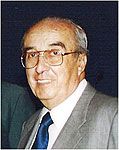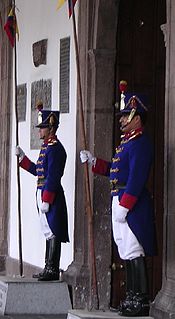Revolutionary Vanguard was a Maoist-oriented political party in Peru founded in 1977 by Eduardo Figari and Julio César Mezzich. It was formed through a split in Revolutionary Vanguard. In 1978 a faction mainly active in the peasant movement around Mezzich and Lino Quintanillo left the VR-PC and most of its members joined individually the Shining Path.

Luis Bedoya Reyes is a Peruvian Christian Democrat (PDC) and Christian People's Party (PPC) politician in the late 1960s. He was the mayor of Lima from 1964 to 1969. He is also a former Minister of Justice, member of the Peruvian Congress and ran for Peruvian president two times. He was the founder of the Christian People's Party (PPC). As of 2019, Bedoya is the oldest Latin American politician, being 100 years old.

Peruvian Ribereño Spanish or Peruvian Coastal Spanish is the form of the Spanish language spoken in the coastal region of Peru. The Spanish spoken in Coastal Peru has four characteristic forms today: the original one, that of the inhabitants of Lima near the Pacific coast and parts south, ; the inland immigrant sociolect ; the Northern, in Trujillo, Chiclayo or Piura; and the Southern. The majority of Peruvians speak Peruvian Coast Spanish, as Peruvian Coast Spanish is the standard dialect of Spanish in Peru.
Alfredo Augusto Torero Fernández de Córdova was a Peruvian anthropologist and linguist.

The Machu Picchu Scientific Base is a Peruvian polar scientific research facility in Antarctica, established to conduct Antarctic research on geology, climatology and biology. More specifically, its purpose is to study the continent's geological past, potential sea resources, wind strengths, air pollution, and the animal adaptation in a freezing environment. The base is named after the World Heritage site Machu Picchu.

Antonio Cornejo-Polar (1936–1997) was a Peruvian-born academic, teacher, literature and cultural critic, known particularly for his theorization of the concept of "heterogeneity."
While many of the media in Peru is over a century old, other such media is relatively new.

A Spanish NATO membership referendum was held on Wednesday, 12 March 1986, to gauge support for the country either remaining a member of, or leaving, the North Atlantic Treaty Organization (NATO), which it had joined in 1982. The question asked was "In your view, should Spain continue to be a member of the Atlantic Alliance subject to the terms agreed by the national Government?". The referendum resulted in 56.9% of voters voting in favour of remaining within NATO on a turnout of 59.4%.

Arequipa is the capital and largest city of the Arequipa Region and the seat of the Constitutional Court of Peru. It is Peru's second most populous city with 861,145 inhabitants, as well as its second most populous metropolitan area as of 2016, according to the National Institute of Statistics and Informatics (INEI)
As of 2009, official statistics showed 137,154 Peruvians in Spain.

The Battle of Tarqui, also known as the Battle of Portete de Tarqui, took place on the 27 February 1829 at Portete de Tarqui, near Cuenca, Ecuador. It was fought between troops from Gran Colombia, commanded by Antonio José de Sucre, and Peruvian troops under José de La Mar.

José de la Riva-Agüero y Osma, 6th Marquess of Montealegre de Aulestia and 5th of Casa-Dávila was a Peruvian historian, writer and politician who served as Prime Minister of Peru, Minister of Justice and Mayor of Lima.

Marayniyoq or Marayniyoc is an archaeological site in the region of Ayacucho in Peru. It lies southeast of the town of Huanta and southwest of Huamanguilla at the border of the Huanta Province, Huamanguilla District and the Huamanga Province, Pacaycasa District in a plain called Vega Pampa. It is considered a Wari site.
Cuchi Machay is an archaeological site with rock paintings in Peru. It is located in the Lima Region, Yauyos Province, Tanta District. Cuchi Machay was declared a National Cultural Heritage of Peru by Resolución Viceministerial No. 011-2013-VMPCIC-MC on February 7, 2013.
The Bi-Oceanico Central railway (CFBC) is a rail project in the countries of Brazil and Peru. The project would join the port of Santos, Brazil and with the port of Callao, Peru,. The cost of the project estimates in $US 20,000 million.
Joan Oliver Araujo is a Spanish author, who holds the chair of Constitutional Law in the University of the Balearic Islands (UIB).
IPSC Peru is the Peruvian association for practical shooting under the International Practical Shooting Confederation.
The Salaverry-Santa Cruz War, sometimes called the Peruvian civil war of 1835–1836, was an internal conflict in Peru with the involvement of the Bolivian army of Andres de Santa Cruz. At the Battle of Yanacocha, Santa Cruz's army lost 211 killed and 71 wounded, while Gamarra's army lost 400 killed and 985 taken prisoner. At the Battle of Uchumayo, Santa Cruz's army lost 315 killed.
The Vargas Brothers Art Studio was an iconic photographic studio operated by the brothers Carlos and Miguel Vargas in Arequipa, Peru. Winning numerous awards for their photography and techniques, the negatives of the studio have been preserved in digital format.












